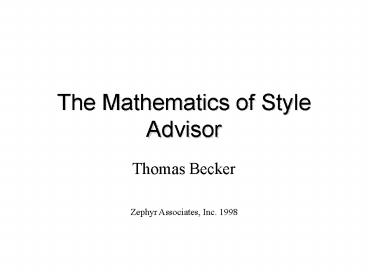The Mathematics of Style Advisor PowerPoint PPT Presentation
1 / 21
Title: The Mathematics of Style Advisor
1
The Mathematics of Style Advisor
- Thomas Becker
Zephyr Associates, Inc. 1998
2
Prequisites
- Basis understanding of statistical terms and
definitions - No knowledge of higher mathematics
3
Overview
- Mathematics of one-window, one-manager style
analysis - Questions and discussion
4
Style analysis as implemented in the StyleAdvisor
program was introduced by Stanford professor and
Nobel laureate William F. Sharpe in his landmark
1988 paper "Determining a funds effective asset
mix" in the Investment Management
Review.Sharpe's method is original and
fundamentally different from standard
mathematical approaches.
5
Basic One-Manager Style Analysis
- The input to style analysis are return series
- Manager M m1, m2, , mt
- Small Growth Rsg r11, r12, , r1t
- Small Value Rsv r11, r12, , r1t
- Large Growth Rlg r11, r12, , r1t
- LargeValue Rlv r11, r12, , r1t
6
The goal of style analysis is to determine
weights wsg, wsv, wlg, wlv for the indices in
such a way that the weighted sum of returnsS
wsgRsg wsvRsv wlgRlg wlvRlvis a style
benchmark for the given manager.
7
What does it mean for the weighted sumS
wsgRsg wsvRsv wlgRlg wlvRlvto be a
style benchmark for the manager?
- The weights represent the true effective asset
mix of the manager. - The excess return of the manager over the style
benchmark is a true measure of the manager's
skill.
8
The goal of style analysis is to determine the
weights wsg, wsv, wlg, wlv in such way that the
graphS wsgRsg wsvRsv wlgRlg
wlvRlvis a best fit for the manager return
graph.
Question What is the criterion of best fit?
9
(No Transcript)
10
The goal of style analysis is not to determine
the weights wsg, wsv, wlg, wlv in such way that
the style benchmark graph and the manager graph
are close to each other.
11
The goal of style analysis is to determine the
weights wsg, wsv, wlg, wlv in such way that the
style benchmark graph and the manager graph run
parallel to each other.
12
Two graphs run parallel to each otherif and only
iftheir difference is a constant.
A graph is constantif and only ifits variance
equals 0.
Two graphs run parallel if and only ifthe
variance of their difference equals 0.
13
The goal of style analysis is to determine the
weights wsg, wsv, wlg, wlv in such way that the
variance of the difference between the style
benchmark series and the manager return series
becomes 0.
The goal of style analysis is to determine the
weights for the asset classes so as to minimize
the variance of excess return.
14
Determine wsg, wsv, wlg, wlv so as to
minimizevar(M - S) var(M-(wsgRsg wsvRsv
wlgRlg wlvRlv))
This can be solved by means of quadratic
optimization.
15
Let C be the covariance matrix of the
indices,i.e., cij covariance between the i-th
index and the j-th index. Let v be a vector with
vi covariance between the i-th index and the
manager. Let w (wsg, wsv, wlg,wlv)Then
var(M-(wsgRsg wsvRsv wlgRlg wlvRlv))
wCwT - 2vwT - var(M)
16
R2
StyleAdvisor allows you to choose between
essentially two definitions of R2 "Correlation
Squared" and "Standard".
17
Standard Let e excess return M - S. ThenR2
1 - var(e)/var(M)
- Minimizing var(e) is equivalent to maximizing the
standard R2. - var(e) 0 if and only if R2 1.
18
It is true that var(M) var(S) var(e) R2 1
- var(e) / var(M) (var(M) - var(e)) /
var(M) var(S) / var(M) Hence, the
standard R2 can be viewed as variance
explained. The approximation above is strict if
and only if S and e have correlation 0.
19
Correlation Squared Here, R2 is the square of
the correlation between the manager and the style
benchmark
R2 (covar(M, S))2 / var(M) var(S)
- The two versions of R2 are approximately equal.
- The equality is close if e and S have low
correlation. The equality is precise if e and S
have correlation 0.
20
Minimizing the variance of excess returnis
equivalent tomaximizing the standard version of
R2 is roughly equivalent to
maximizing the correlation between manager and
style benchmark.
21
The premise of style analysis is that the
correlation between S and e is low, i.e., style
and selection are uncorrelated.

